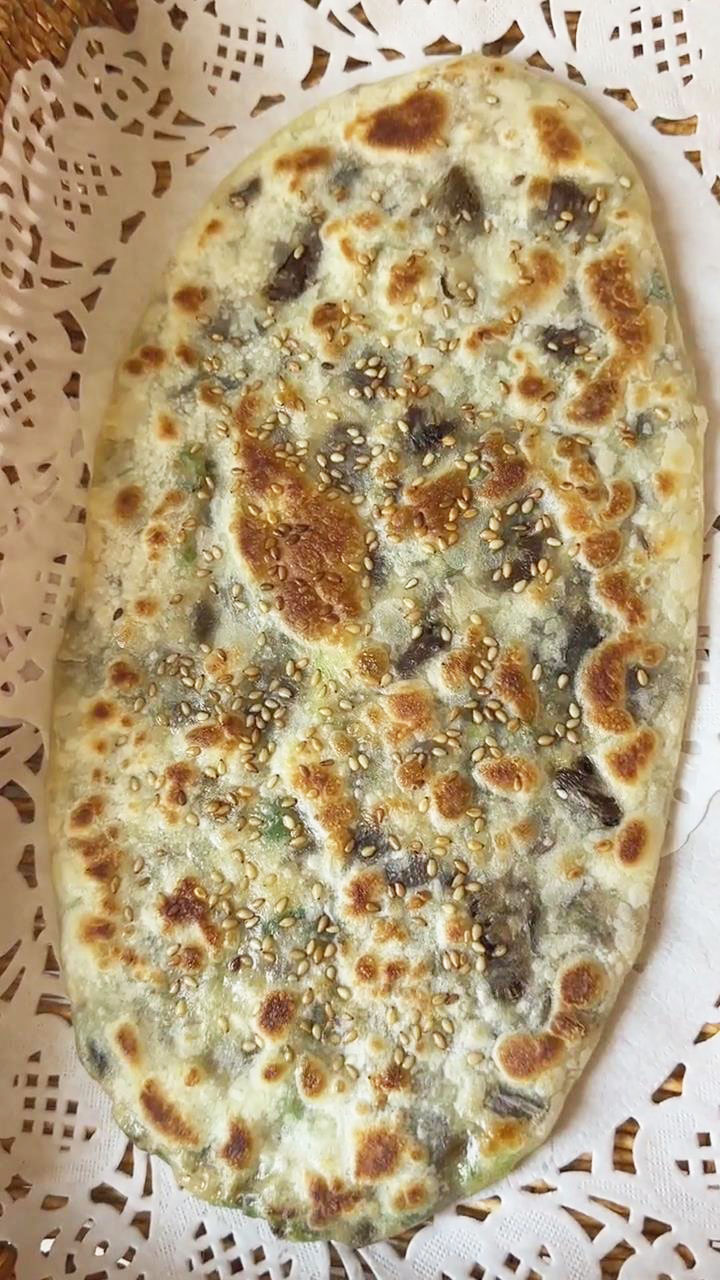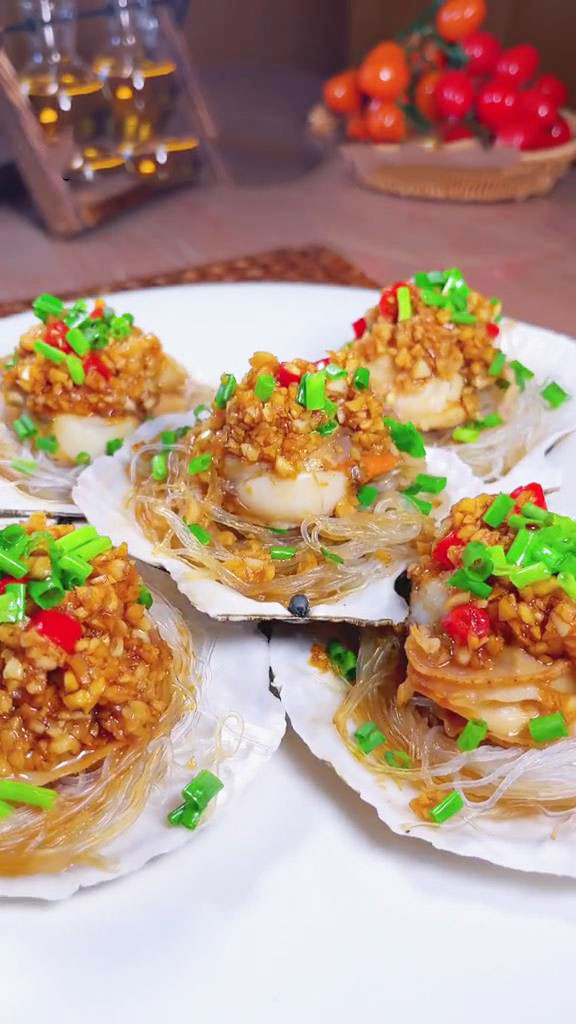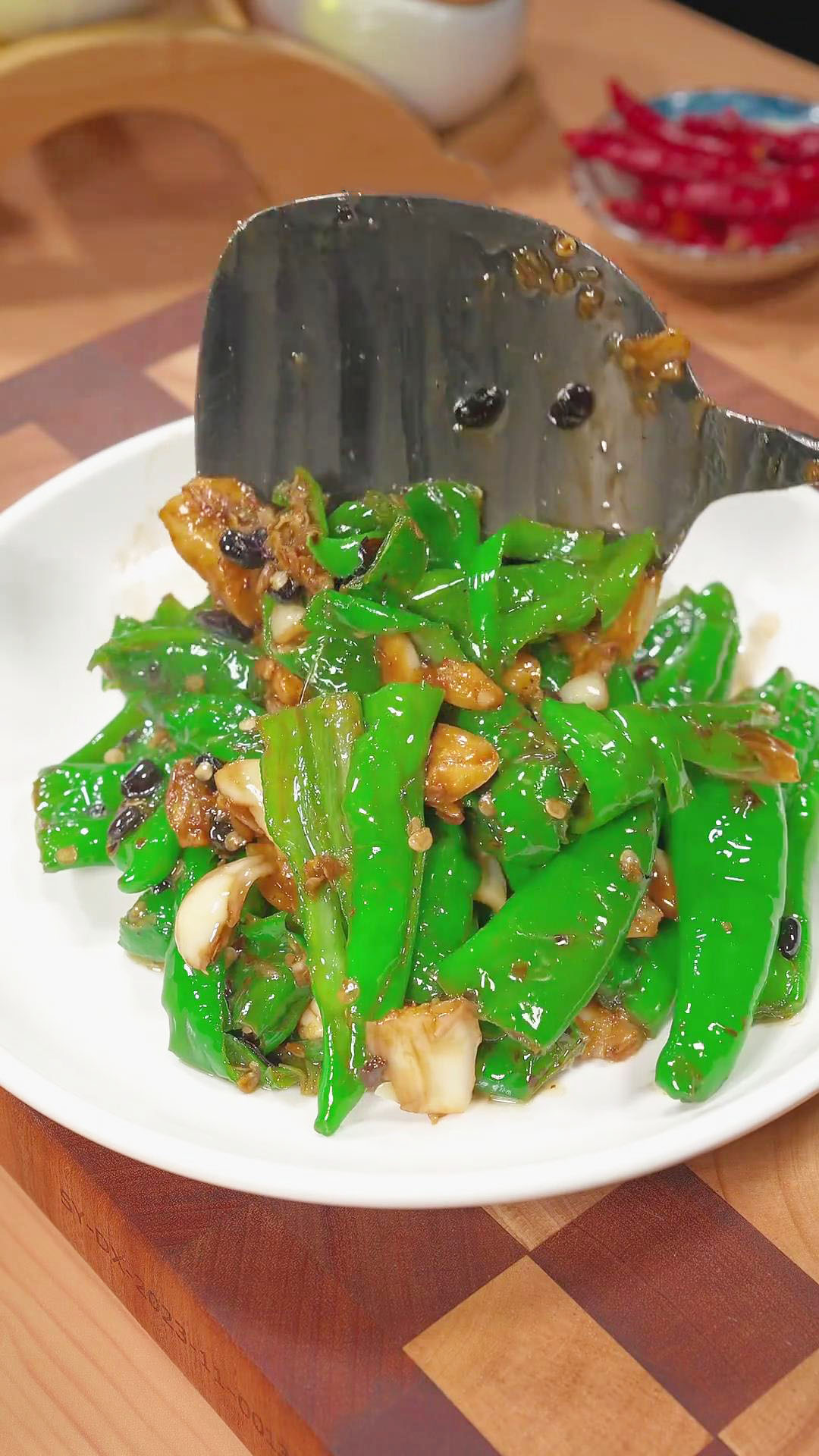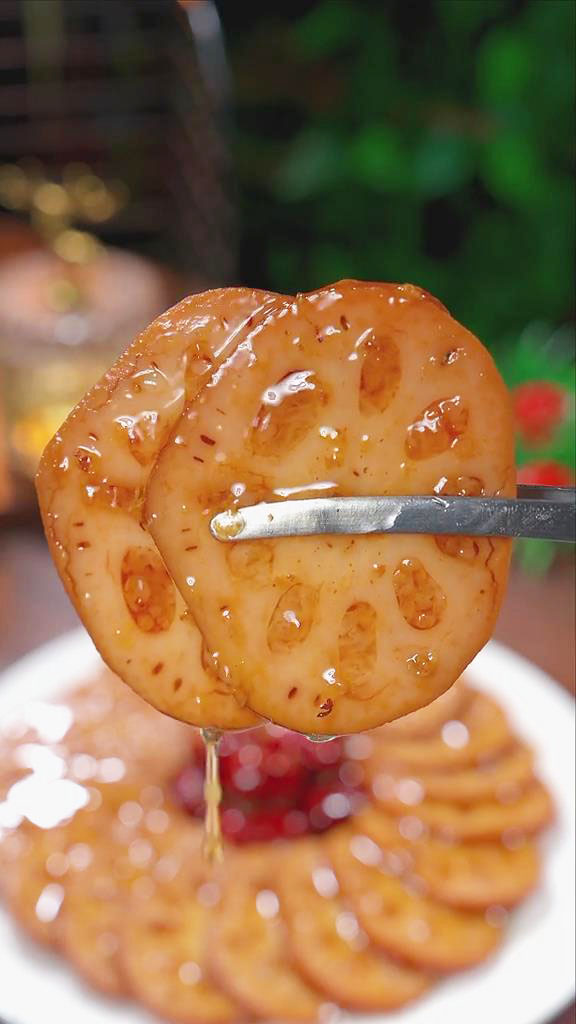This post may contain affiliate links. Please read our disclosure policy.
It‘s flaky, crispy, and savory! Guo Kui is a crispy flatbread stuffed with savory meat and vegetable filling seasoned with pantry-friendly seasonings. Simply make the dough, prepare the filling and oil paste, assemble, and cook by either baking or pan-frying.
All About Guo Kui (Crispy Stuffed Flatbread)
Do you enjoy my Shaobing recipe (Chinese sesame flatbread) or my Baked Suzhou Mooncake recipe? Or perhaps you simply enjoy flaky pastries like wife cakes? If yes, here’s another flaky, crispy flatbread called guo kui.
You may also know guo kui as Chinese pizza or pan helmet. It is a beloved street food snack in China, popularly eaten as a fast and easy-to-carry snack. You can typically find sweet or savory guo kui.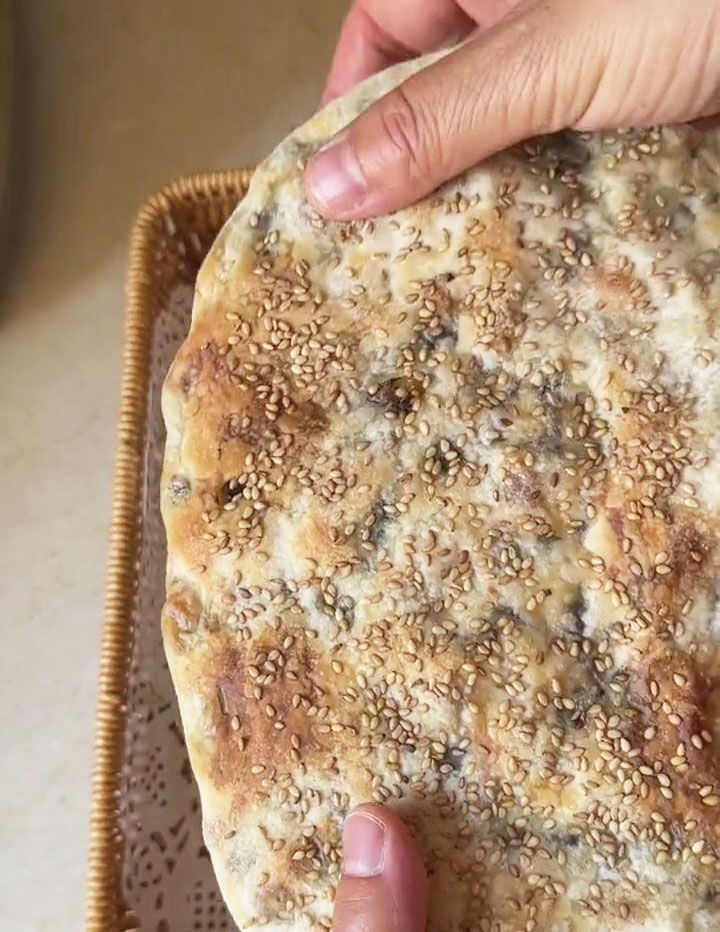
However, guo kui with a savory filling is more common. For this recipe, the filling is savory and made with minced meat, meigan cai, green onions, and various seasonings. The bread is made with dough and an oil paste to make the iconic flaky, crispy texture.
In a nutshell, simply knead the dough, make the savory filling, combine the oil paste with the dough, roll the dough with the filling, and bake.
You can top it with sesame seeds before baking for that extra nutty crunch. Aside from baking, you can pan-fry the flatbread with a bit of oil until golden brown and crispy. 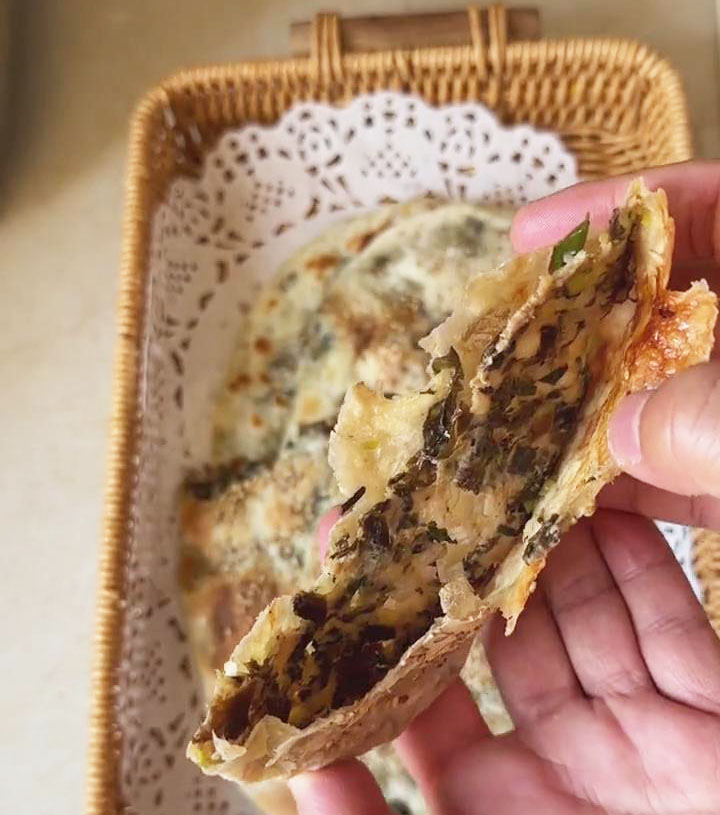
Ingredient Tips And Alternatives
Need tips about the ingredients and which alternatives to use? Then don’t skip this part yet. Here’s what to know about the ingredients:
For the dough:
- Flour: Use all-purpose flour for your dough base. I always use all-purpose flour to make various buns, such as Bunny Steamed Buns, Piggy Buns, and Peach Buns, as well as mooncakes like Suzhou Mooncake and Mooncakes with Egg Yolk and Lotus Paste. Some good alternatives to plain flour are other types of flour, such as barley flour, bread flour, or a combination of plain and whole wheat flour. You can use these alternatives but the texture may vary depending on the type of flour. Do not use special flour like rice flour or glutinous rice flour since these will give you a sticky and chewy texture.
- Salt: Salt adds a better taste to the dough and brings out the flavor and aroma. Moreover, it makes the dough stronger and tightens the gluten strands. Use any type of salt, such as sea salt, pink salt, and kosher salt.
- Water: Water is needed to make a pliable, soft dough. The dough will be more pliable if you use warm water or room-temperature water.
For the filling:
- Meigan cai: Meigan cai or mei cai is a dried pickled Chinese mustard which lends a savory, earthy taste to the filling. I soaked it in water for 20 minutes until soft and rehydrated. You can buy it in Asian grocery stores or online markets like Amazon.
- Pork belly: I used about 200g of chopped pork belly and blended it with green onions in a food processor. If you are not into pork, swap it with beef or chicken. For a plant-based alternative, I recommend crumbled tofu, minced soy meat, plant-based pork, or chickpeas.
- Green onion: Green onions or scallions lend a mild, sweet, oniony taste. I used one batch to grind with the meat and another to mix it with the entire filling. You can swap green onions for spring onions or chives. In terms of taste, spring onions are sweet and pungent, whereas chives are light with a mild, garlicky taste.
- Salt: Salt is an all-around flavor enhancer that brings out the flavors of the seasonings. It helps the filling absorb the seasonings better. Use any type of salt, such as sea salt, pink salt, and kosher salt.
- Light soy sauce: Turn a bland filling into savory, and umami with a bit of soy sauce. I used light soy sauce, but you can also use tamari, liquid aminos, coconut aminos, or gluten-free soy sauce.
- White pepper powder: White pepper adds an earthy taste and subtle heat. This is a bit different from black pepper powder which is more woody, piney, and hot. You can swap white pepper powder with black pepper if needed.
- Oil: Adding oil to the filling keeps it moist and prevents it from drying out. Any cooking oil will do. For a healthier option, use olive, avocado, sesame, or safflower oil. If you want a neutral taste, go for peanut, soybean, or vegetable oil.
- Sugar: The sugar will balance out the saltiness of the meat and soy sauce. You can use any type of sweetener, including white sugar, cane sugar, brown sugar, maple syrup, or coconut sugar.
For the oil paste:
- All-purpose flour + Oil: Flour makes the oil paste thick and creamy. Use all-purpose flour and mix it with your choice of oil. When the oil paste is flattened and rolled with the dough, it will create the flaky layers of the flatbread.
- Salt and pepper seasoning: To season the oil paste, mix in Salt And Pepper seasoning and adjust to taste. You can buy this in the spice section of your local grocery store or online on Amazon. If you don’t know yet, this seasoning is a blend of six spices, including Sichuan peppercorn, fennel seed, shrimp skin, white sesame, salt, Chinese five-spice powder, and paprika (optional for a slightly spicy taste). It’s nice to have an extra supply of this unique seasoning since you can make salt and pepper dishes, such as salt and pepper tofu, salt and pepper pork chops, and salt and pepper chicken wings, to name a few.
Toppings:
- White sesame seeds: Before baking or pan-frying, sprinkle a generous amount of sesame seeds on top of the flatbread dough. This adds a delightful nutty crunch and aroma. Alternatively, you can use black sesame seeds, but it will give a stronger nutty taste.
Expert Tips For A Successful Flatbread
Whether you are making flatbread for the first time or not, why not read this section first? The following section provides tips on how to make the dough for a successful flatbread texture. Before you begin, here are some things you should know:
- Measure by weight. Measuring by weight is the most accurate way to get the right amount of ingredients. Use a kitchen weighing scale to get accurate measurements. In this way, you get a soft, pliable dough that is not sticky or stiff. If the dough is too wet or sticky, gradually add flour in small amounts. If it is too stiff, gradually add water. Do the adjustment in small amounts to avoid overdoing it.
- Knead until you have a smooth dough. Kneading should not be rushed. Keep kneading until you create a smooth, pliable dough. The more you knead the dough, the smoother it becomes. If the dough keeps sticking to the surface during the kneading step, dust the surface with a bit of flour. Kneading is done once when the dough ingredients are combined and divided.
- Rest the dough after kneading.I let the dough rest for 30 minutes after kneading and dividing. Do not skip or rush the resting step, as this is key in letting the gluten relax and hydrate. Resting makes the dough hold its shape better, making it stronger to prevent deforming easily.
- Flatten and roll the dough with the oil paste. This process involves flattening, pressing, and rolling. After making the dough portions, flatten it into a long oblong strip. Then, brush the top with the oil paste and roll the dough inward. Seal the edges and press it against your hand to form a flat circle. Afterward, flatten it with a thin circular wrapper with a rolling pin. This coiling technique is the secret to making the flaky, layered texture of the flatbread.
Ingredients And Baking Tools Needed
Here are my recommended baking tools and ingredients to get started:
Baking Tools:
- Mixing bowls
- Chopsticks
- Dough cutter
- Airtight container or plastic wrap
- Food processor or blender
- Rolling pin
- Pastry brush
- Parchment paper
- Baking tray lined with parchment paper (or non-stick pan for frying)
Ingredients:
For the dough:
- 300g all-purpose flour
- 3g salt
- 180g warm water
For the filling:
- 1 cup meigan cai (soaked and drained)
- 200g pork belly
- 10g green onions
- 1 tsp salt
- 1 tbsp light soy sauce
- A dash of white pepper
- 1/2 cup chopped green onions
- 2 tbsp oil
- 1 tsp white sugar
For the oil paste:
- 2 tbsp all-purpose flour
- 1/2 tablespoon salt and pepper seasoning
- 2 tablespoons oil
Toppings:
- White sesame seeds (or black sesame seeds)
Steps To Make Guo Kui
The steps are detailed below with pictures for guidance. You can also watch my 2-minute tutorial video on Instagram or TikTok for a clearer understanding of how to knead, flatten, and roll the flatbread. When you are done making this recipe, remember to share a photo to show the results with the tag @kitchenmisadventures.
Did you like this recipe? If you have tips and recommendations for this recipe, leave a comment in the comments section. Discover more pastry dishes by checking out Chinese Sachima Soft Flour Pastry Cake (沙琪瑪), Pandan Cake, and Oven-Baked Red Bean Bread.
Knead The Dough
- Mix all-purpose flour with salt.
- Pour warm water and mix well with chopsticks.
- Knead the dough until smooth.
- Roll it into a long log and divide the dough into 8 portions using a dough cutter.
- Roll each dough portion into a small ball, then shape into cylinders.
- Transfer to an airtight container and cover with a lid or plastic wrap to seal. Covering it is important to prevent the dough from drying out and absorbing too much air.
- Let it sit for half an hour.
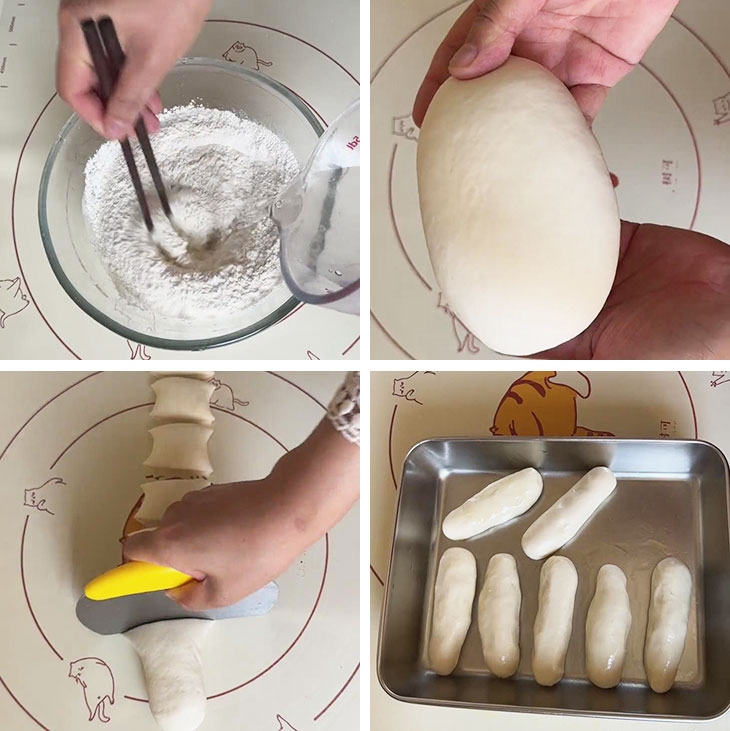
Make The Filling
- Soak the meigan cai in water for 20 minutes. Set aside.
- Prepare the meat or plant filling. Blend the pork belly with some chopped green onions.
- Season with salt, light soy sauce, and white pepper. Mix it well.
- Drain the soaked meigan cai and squeeze out as much water as you can. Mix it with the filling, along with chopped green onions, a bit of edible oil, and a pinch of white sugar. Stir well.
- Make the oil paste by combining flour, salt and pepper seasoning, and edible oil. Keep mixing until you have a smooth, creamy but runny paste.
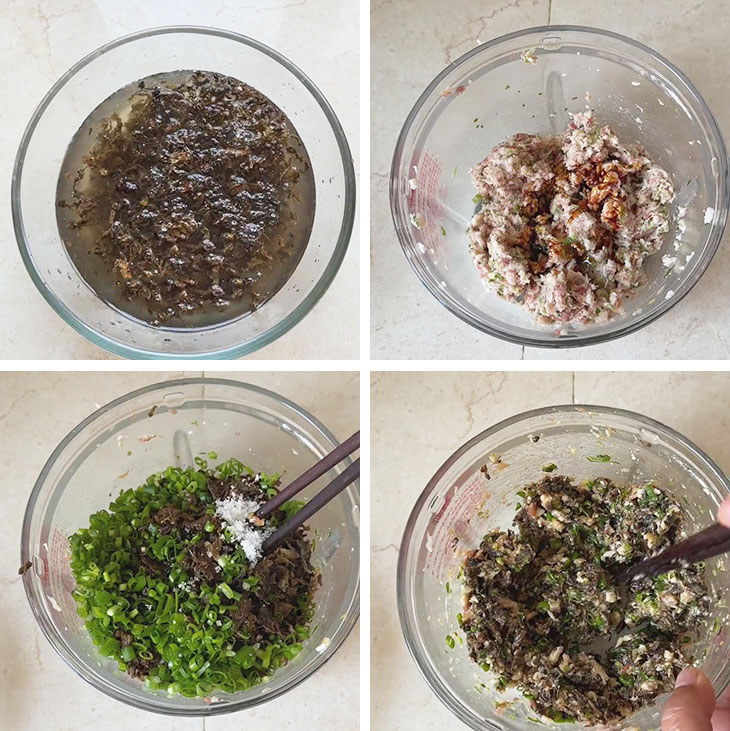
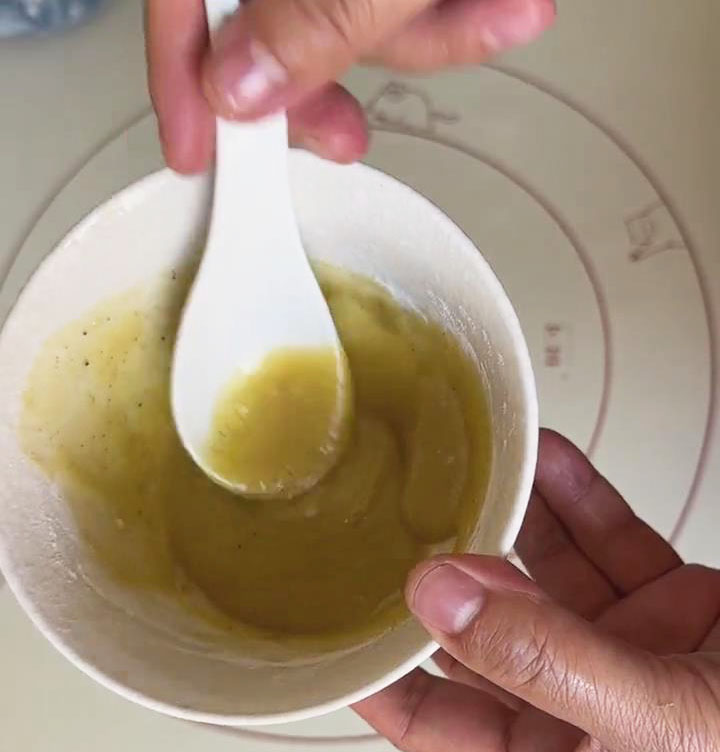
Assemble The Dough And Filling
- Take out the dough portions and roll out each into a thin oblong strip. Use a rolling pin for this step.
- Brush the oil paste on top using a pastry brush.
- Then, roll it up from one end to the other, making it look like spring rolls.
- Seal both ends by pinching the edges together and sealing the rolled up end.
- Press the dough with the palm of your hand, giving you a flattened ball of dough.
- Use a rolling pin to flatten the dough into a thin, circular wrapper, making sure the center is slightly thicker than the edges. This step is similar to making the bun wrapper for egg yolk buns. To do this, use one hand to hold and spin the dough and the other hand to roll the rolling pin to flatten the edges. Repeat these steps for the rest of the dough portions.
- Place a portion of the filling (about 2 tablespoons) on the center of each dough wrapper and seal the edges to form a creased bun.
- Roll the buns as thin as possible until you have a thin oblong flatbread dough. To do this step, roll the rolling pin until it flattens, then turn the dough to the other side and roll it out again. Keep rolling and turning the dough until it is larger in size and thinner. Don’t worry if it tears a bit; it’s okay. In this step, it helps to lightly dust the surface with a bit of flour to prevent the thin dough from sticking to the surface.
- Lightly spray it with water and sprinkle sesame seeds on top.
- Place each flatbread on a sheet of parchment paper. I recommend placing the dough on parchment paper to prevent it from sticking to the surface.
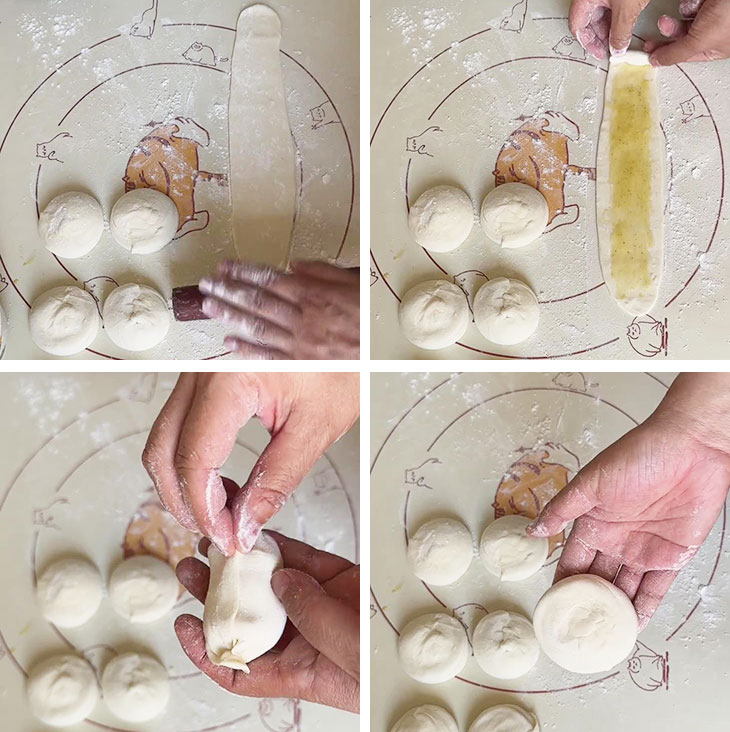
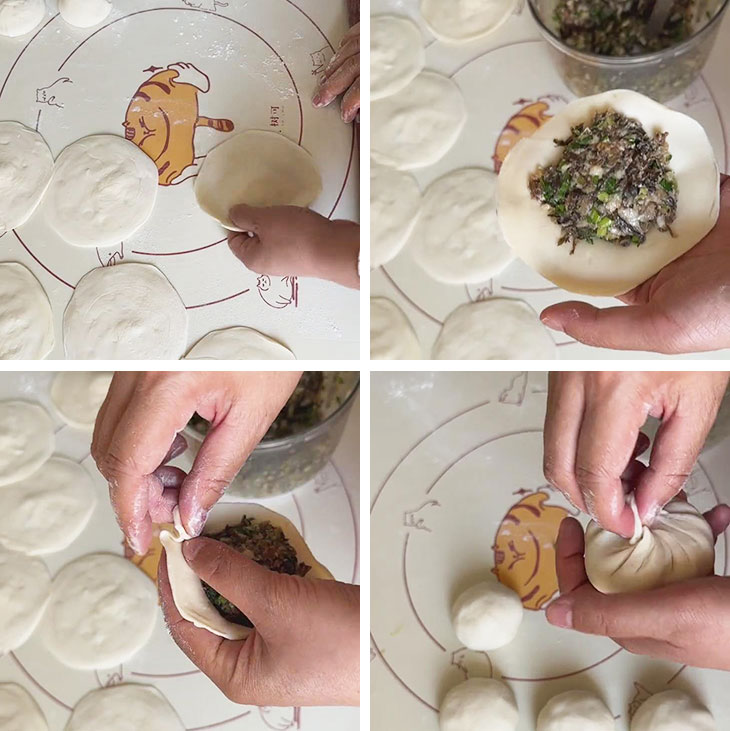
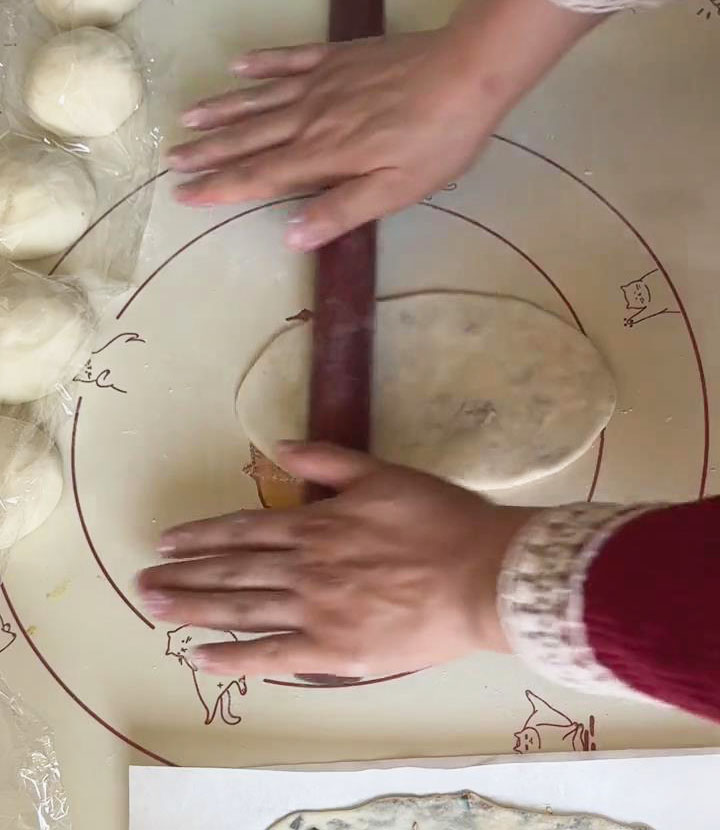
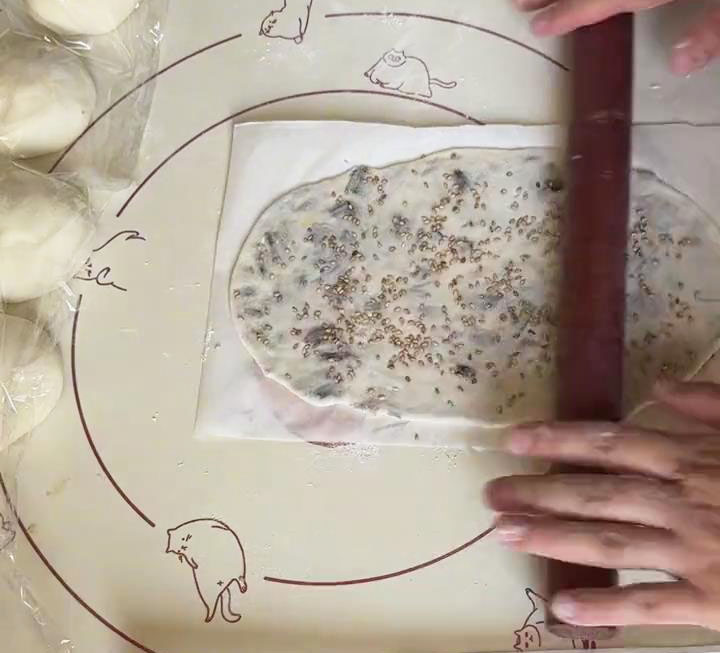
Bake The Flatbread
- Transfer the flatbread with the parchment paper to a baking tray.
- Bake the guo kui in a preheated oven at 230 degrees Celsius for 9 minutes or until golden brown and crispy.
- Alternatively, pan-fry them with a spray of oil until crispy and golden brown on both sides.
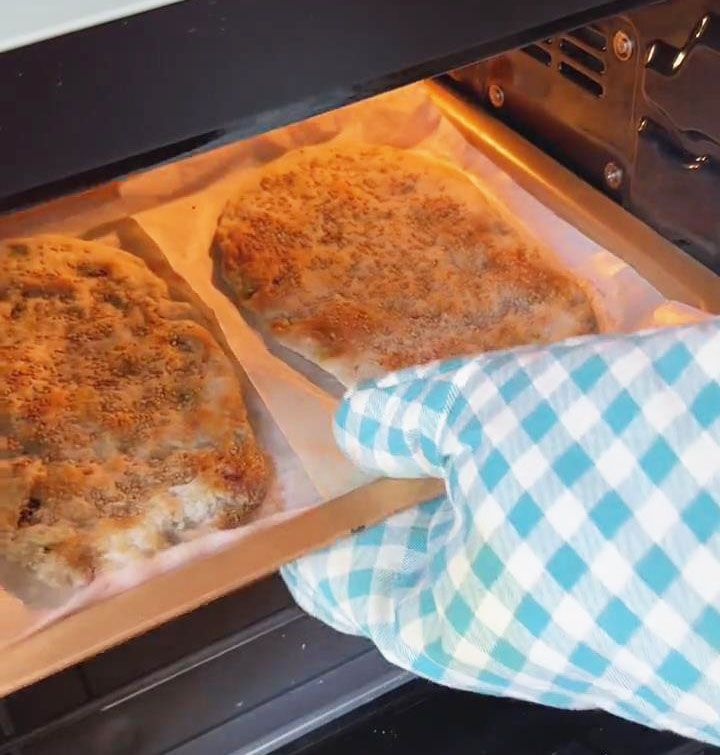

Final thought
I admire making Guo Kui, although it can be a bit time-consuming. However, you can make a large batch to save time in the long run. What I love about Guo Kui is that it freezes well, similar to buns, dumplings, scallion pancakes, and zongzi. This makes it easy to prepare a delicious Chinese breakfast with frozen Guo Kui, which pairs wonderfully with porridge.
How to Store Guo Kui
- Layer with Parchment Paper: Stack the Guo Kui with a piece of parchment paper between each one.
- Seal with Plastic Wrap: Tightly seal the entire stack with plastic wrap to keep them fresh.
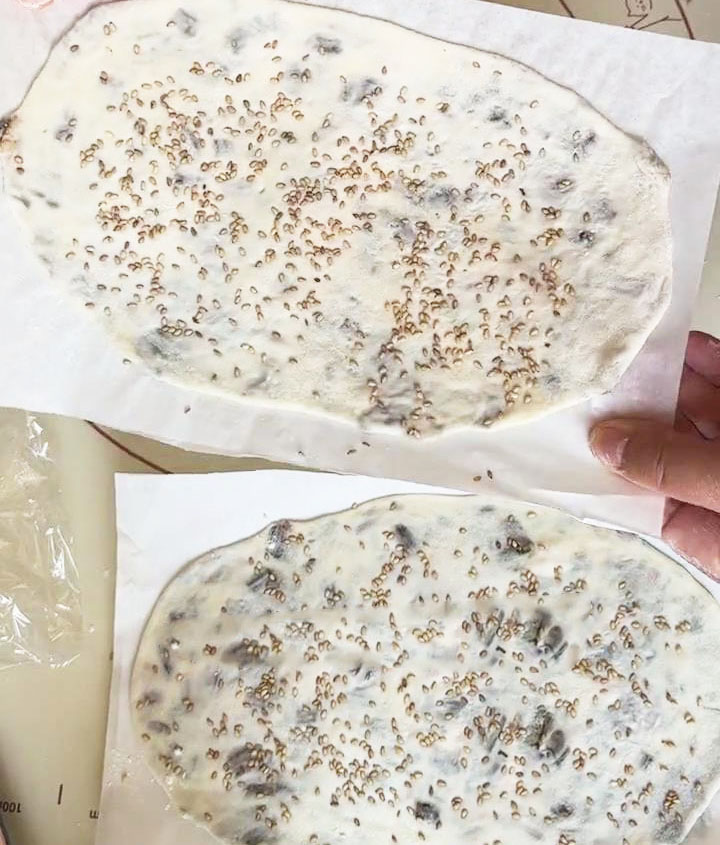
How to Cook Frozen Guo Kui (No need to defrost)
For Pan Frying:
- Spray oil on the pan.
- Pan fry on the lowest heat with the lid covered for about 8 minutes, flipping halfway through.
For Baking in the Oven:
- Preheat the oven to 230°C (450°F).
- Bake for 11 minutes.
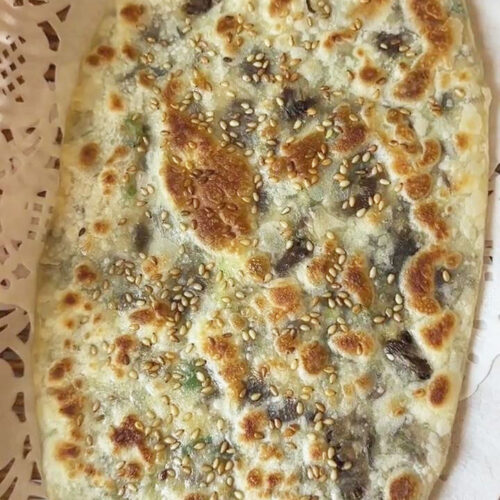
Homemade Guo Kui (Crispy Stuffed Flatbread/锅魁)
It's flaky, crispy, and savory! Guo Kui is a crispy flatbread stuffed with savory meat and vegetable filling seasoned with pantry-friendly seasonings. Simply make the dough, prepare the filling and oil paste, assemble, and cook by either baking or pan-frying.Ingredients
For the dough:
- 300 g all-purpose flour
- 3 g salt
- 180 g warm water
For the filling:
- 1 cup meigan cai soaked and drained
- 200 g pork belly
- 10 g green onions
- 1 tsp salt
- 1 tbsp light soy sauce
- 1/2 tsp white pepper
- 1/2 cup chopped green onions
- 2 tbsp oil
- 1 tsp white sugar
For the oil paste:
- 2 tbsp all-purpose flour
- 1/2 tablespoon salt and pepper seasoning
- 2 tablespoons oil
Toppings:
- White sesame seeds or black sesame seeds
Instructions
Knead The Dough
- Mix all-purpose flour with salt.
- Pour warm water and mix well with chopsticks.
- Knead the dough until smooth.
- Roll it into a long log and divide the dough into 8 portions using a dough cutter.
- Roll each dough portion into a small ball, then shape into cylinders.
- Transfer to an airtight container and cover with a lid or plastic wrap to seal. Covering it is important to prevent the dough from drying out and absorbing too much air.
- Let it sit for half an hour.
Make The Filling
- Soak the meigan cai in water for 20 minutes. Set aside.
- Prepare the meat or plant filling. Blend the pork belly with some chopped green onions.
- Season with salt, light soy sauce, and white pepper. Mix it well.
- Drain the soaked meigan cai and squeeze out as much water as you can. Mix it with the filling, along with chopped green onions, a bit of edible oil, and a pinch of white sugar. Stir well.
- Make the oil paste by combining flour, salt and pepper seasoning, and edible oil. Keep mixing until you have a smooth, creamy but runny paste.
Assemble The Dough And Filling
- Take out the dough portions and roll out each into a thin oblong strip. Use a rolling pin for this step.
- Brush the oil paste on top using a pastry brush.
- Then, roll it up from one end to the other, making it look like spring rolls.
- Seal both ends by pinching the edges together and sealing the rolled up end.
- Press the dough with the palm of your hand, giving you a flattened ball of dough.
- Use a rolling pin to flatten the dough into a thin, circular wrapper, making sure the center is slightly thicker than the edges. This step is similar to making the bun wrapper for egg yolk buns. To do this, use one hand to hold and spin the dough and the other hand to roll the rolling pin to flatten the edges. Repeat these steps for the rest of the dough portions.
- Place a portion of the filling (about 2 tablespoons) on the center of each dough wrapper and seal the edges to form a creased bun.
- Roll the buns as thin as possible until you have a thin oblong flatbread dough. To do this step, roll the rolling pin until it flattens, then turn the dough to the other side and roll it out again. Keep rolling and turning the dough until it is larger in size and thinner. Don't worry if it tears a bit; it's okay. In this step, it helps to lightly dust the surface with a bit of flour to prevent the thin dough from sticking to the surface.
- Lightly spray it with water and sprinkle sesame seeds on top.
- Place each flatbread on a sheet of parchment paper. I recommend placing the dough on parchment paper to prevent it from sticking to the surface.
Bake The Flatbread
- Transfer the flatbread with the parchment paper to a baking tray.
- Bake the guo kui in a preheated oven at 230 degrees Celsius for 9 minutes or until golden brown and crispy.
- Alternatively, pan-fry them with a spray of oil until crispy and golden brown on both sides.
Video
Nutrition
Calories: 681kcalCarbohydrates: 62gProtein: 14gFat: 41gSaturated Fat: 11gPolyunsaturated Fat: 7gMonounsaturated Fat: 21gTrans Fat: 0.1gCholesterol: 36mgSodium: 2015mgPotassium: 228mgFiber: 3gSugar: 2gVitamin A: 155IUVitamin C: 3mgCalcium: 27mgIron: 4mgTried this recipe?Let us know how it was!

